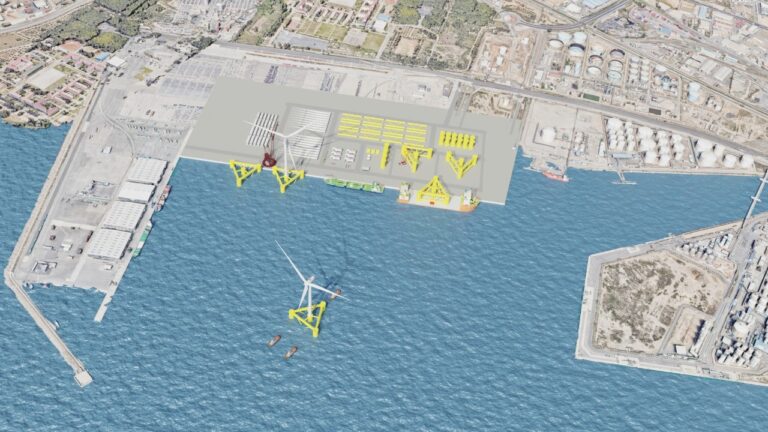Italy has significant opportunities for the development of floating offshore wind, contributing to the decarbonization path and creating value for the industry and local sectors.
- Today, The European House – Ambrosetti, in collaboration with partners Renantis, BlueFloat Energy, Fincantieri, and Acciaierie d’Italia, presented the Strategic Study of the Floating Offshore Wind Community. The initiative aims to highlight the contribution of floating offshore wind to the country’s decarbonization process and the opportunities this technology presents for the Italian industry and local sectors.
- The study highlights 10 strengths of floating offshore wind, providing a new perspective on 10 misconceptions about the topic. Italy is an ideal location for hosting and producing green energy through floating wind technology, substantially contributing to decarbonization goals. With the potential to become the third-largest global market and contribute 60% to the entire energy demand, Italy could aspire to a leading position in the industry, leveraging its established industrial chain in steel and shipbuilding.
- Moreover, floating offshore wind, with its efficiency and reduced environmental impact, could have positive repercussions on the territory, contributing to the economy and employment, creating value for host communities, including long-term compensation measures.
Rome, February 2, 2024 – Highlighting the contribution of floating offshore wind to the country’s decarbonization process and the positive economic and local sector impacts of this technology is the goal of the Floating Offshore Wind Community project, created by The European House – Ambrosetti in collaboration with partners Renantis, BlueFloat Energy, Fincantieri, and Acciaierie d’Italia. The conclusion of the first year of the Community culminated in a roundtable where over 50 executives from companies and institutions engaged in discussions at the stunning Anantara, Palazzo Naiadi in Rome.
“We are at a decisive moment in history for the country’s decarbonization and achieving clean energy targets by 2030 and 2050. To meet this challenge, Italy must leverage floating offshore wind, which has strong energy potential and limited environmental and social impacts. The Italian industrial system also has significant expertise in the steel and shipbuilding sectors, which can be exploited to build a leadership position in the global market for this technology, with significant benefits, especially in Southern regions. The Community has worked this year to raise awareness about the potential of this green technology and the urgency to initiate investments, proposing a specific roadmap of actions to provide certainty to investors so that the national industrial value chain can organize and invest seriously in floating offshore wind, generating positive impacts on the Italian economy and employment,” commented Valerio De Molli, Managing Partner & CEO of The European House – Ambrosetti.
“The Strategic Report presented today by the Community clearly highlights how floating offshore wind technology is crucial not only for achieving decarbonization targets but also, and I would say especially, for the goal of making the country energy independent. The challenges ahead require a systemic approach and a vision that could be summarized whose watchword can only be one: without all the various forms of renewable energy, we will not go anywhere. In this perspective, the Community’s study highlights the enormous potential of floating offshore wind, whose benefits go beyond the energy sector, presenting itself as an opportunity for industrial development and economic growth. Renantis, together with BlueFloat Energy, is developing 6 floating offshore wind farms in Italy, with a total investment of 18 billion euros and an installed capacity of 5,500 megawatts. We have already invested several million euros, demonstrating our belief in the country’s potential. However, this is not enough. Investors need clear and reliable rules, streamlined authorization processes, and certain timelines. In this regard, we strongly reiterate the urgency of enacting the FER2 decree, providing for the indexation of auction tariffs at least to inflation, as is already the case in other European countries and in our country for onshore wind. Renantis has enthusiastically participated in the Community; the hope is that this study represents an additional opportunity for dialogue and effective collaboration between policymakers and private investors,” commented Toni Volpe, CEO of Renantis.
“Floating offshore wind is ideally suited to address Italy’s energy security needs by providing large-scale decarbonised energy solutions to fuel its economic growth. Moreover, from the regional perspective, the Mediterranean basin is poised to become a hub for commercial deployment of floating offshore wind; with France, Spain, Italy and Greece seeking to unlock the potential of this technology and Italy being strategically positioned to leverage this regional market. As a pure offshore wind player with a market-leading expertise in floating technology, BlueFloat Energy is proud to having contributed to the European House – Ambrosetti Floating Offshore Wind Community Report, a first-of-its-kind report analysing the potential of floating offshore wind technology in the Italian market. We are fully aligned with the findings of the report with regards to the importance of the policy-makers providing a clear roadmap for offshore wind deployment and demonstrating unwavering commitment, supported by a well-defined implementation plan. BlueFloat Energy has been working hard over the last three years with our partner Renantis to contribute to the development of floating offshore wind industry in Italy and will continue to leverage its global experience to ensure Italy can fully benefit from the technological advances in this rapidly-evolving sector,” said Carlos Martin Rivals, CEO of BlueFloat Energy.
“The decarbonization of Italy can be achieved by strategically focusing on the skills and exceptional industrial know-how of our country. This change can also promote economic and employment growth, especially in the South. Floating offshore wind technology is an unprecedented opportunity for Italy, with the prospect of generating significant employment, estimated at up to 27,000 jobs by 2050. We are confident in the potential of our country and its industrial fabric, determined to be a protagonist in floating offshore wind, an industry in which Fincantieri already boasts solid expertise,” said Pierroberto Folgiero, CEO of Fincantieri.
“Our participation in this strategically important development project is based on two reasons. On the one hand, we are the certified Italian producer of quality steel for structural use and, therefore, capable of producing the steel needed for wind farms, which constitute a huge development pool at the European level for this market. In particular, Acciaierie d’Italia has set a new paradigm in steel sustainability by creating, in collaboration with RINA, a scientific platform for constant monitoring and verification of environmental controls. The Penisola Steel® process, based on this platform, defines and makes recognizable the low environmental impact of the steel produced by our plants throughout the supply chain. On the other hand, Acciaierie d’Italia is a significant consumer of energy, and to support the energy transition of the Taranto plant towards progressive decarbonization, it aims to increase the use of renewable green energy, thus constituting, as a large consumer of this energy, an economic reference as well. Also, thanks to this project, developed with relevant and industry-leading partners, Acciaierie d’Italia confirms itself as an important production, technological, and economic reference for the Italian industrial system,” said Lucia Morselli, CEO of Acciaierie d’Italia.
Introduction: Floating offshore wind is a necessary technology
The Floating Offshore Wind Community is founded on the strong belief that the synergetic and complementary contribution of all available clean technologies should be exploited to accelerate the decarbonization process and achieve climate neutrality goals by 2050. In fact, by 2050, it is expected that Italy’s electricity production will more than double compared to the current level (600-700 TWh vs. 276 in 2022), with renewables contributing between 95% and 100% to total electricity generation. Wind energy will be crucial, representing up to 23% of the total electricity generated (from 7% in 2022), of which up to 10% will come from offshore wind, requiring the installation of at least 20 GW of floating offshore wind capacity by 2050.
Impacts and Energy Potential for Italy
A widespread misconception regarding the adaptability of floating offshore wind to the context of the Mediterranean Sea has been debunked by the Community’s study. Indeed, it concludes that floating wind technology is the most suitable solution for increasing renewable energy capacity, resulting in an environmental impact estimated to be up to 67%lower than of the impact of electricity currently drawn from the Italian grid. Moreover, since floating turbines do not have to be piled into the seabed, they are less impactful compared to fixed-bottom structures, reducing potential disruption to marine habitats and being almost invisible on the horizon due to their siting far away from the coast.
The Community’s study has also provided a different perspective on the criticism concerning the lack of potential for the development of floating offshore wind in Italy. Thanks to its morphological characteristics and the configuration of its seabeds, Italy has enormous potential. Indeed, Italy ranks as the third-largest global market for floating offshore wind development, according to the Global Wind Energy Council. Estimates in collaboration with the Polytechnic University of Turin indicate a potential of 207.3 GW in Italy for floating offshore wind, representing more than 60% of the total renewable energy potential, with Sardinia, Sicily, and Puglia among the areas with the greatest potential.
International Development
While global leaders decisively focus on this technology, setting ambitious targets for 2030 and 2050, the draft update of our Integrated National Energy and Climate Plan (PNIEC) foresees that only 2% of the renewable electric power capacity target for 2030 will come from offshore wind farms, demonstrating that this technology is still considered marginal in Italy (at least by 2030), despite the country having ample potential in terms of marine space.
Development of a national floating offshore wind supply chain enables value creation in local territories
Another misconception worth reconsidering concerns the alleged immaturity of the Italian supply chain in supporting ambitious targets for floating offshore wind by 2030 and 2040. In reality, Italy boasts leadership in several sectors related to the production of technologies necessary for the development of floating offshore wind, especially in steel shipbuilding industries, and port infrastructure, which collectively generate a total of €255.6 billion and employ 1.3 million people in the country.
Contrary to the mistaken perception that renewable energy development rarely generates value in local areas, floating offshore wind could have significant positive impacts on Italian local communities, especially in Southern regions. The creation of a national supply chain for this technology – involving manufacturing, assembly, turbine integration, as well as design and maintenance – could generate a cumulative added value between 2030 and 2050 of €57 billion, activating national supply chains and resulting in employment opportunities. In the scenario of realizing 20 GW by 2050, around 27,000 new jobs could be generated in Italy by 2050.
Proposals for Development in Italy
In conclusion, the Community has highlighted some open issues to be addressed in order to enable the development of floating offshore wind in Italy. Firstly, to ensure significant investments in the sector, it is essential to define a clear long-term industrial vision, with a target of at least 20 GW by 2050 serving as a stimulus for national companies and attracting foreign investments. It will be important, in this regard, to establish intermediate objectives for 2035 and 2040, along with transparent and long-term planning for auctions to finance projects.
In this sense, it is also crucial to accelerate the implementation of maritime spatial plans (MSP), for which Italy is in infringement proceedings with the EU for not yet submitting the required plan. In the short term, a decentralized mechanism is proposed to quickly identify suitable sites for offshore wind development, involving developers and facilitating the participation of multiple stakeholders for rapid development. Meanwhile, the implementation of MSP should proceed with a centralized approach, enhancing stakeholder involvement. Such approaches have already been successfully applied in other nations such as Ireland.
To ensure acceptance of floating offshore wind farms by stakeholders, local communities, and institutions, a collaborative approach is essential. This involves engaging territories and economic operators from the early stages, including during the design phase, to enhance public debate and involve regions in the authorization process, developing a “compensation charter” for long-term measures. Additionally, it is necessary to strengthen auction criteria to ensure a commitment to locating the supply chain for floating offshore wind in Italy.
Given the significant industrial benefits that the development of floating offshore wind can generate, it is essential to create a clear framework of economic incentives to accelerate investments and stimulate the national industrial chain. The publication of the FER2 Decree, supporting the production of energy from innovative renewable sources, is a key element. Constant updates of auction tariffs with inflation and subsidies for crucial infrastructure capex are equally indispensable to ensure the competitiveness of national projects and contribute to generating employment in our country.
Finally, it is essential to strengthen Terna’s role in implementing an infrastructure network development plan for floating offshore wind projects, fostering constant dialogue between Terna and offshore wind sector operators to manage numerous requests and integrate connection request and Environmental Impact Assessment systems.
For more information:
Press Office The European House – Ambrosetti
Silvia Lovati +39 338 3430415
Email: silvia.lovati@ambrosetti.eu
Fabiola Gnocchi +39 349 7510840
Email: fabiola.gnocchi@ambrosetti.eu



